Introduction
Digitalization is essential for business development in the competitive technological era (Tiwari, 2021). It enhances decision-making precision and efficiency through rapid data processing and objective analysis (Zaslavskaya, 2022), leading to a new economic paradigm (Kolmykova et al., 2020). Developing organizational strategies that consider digital innovation’s role in company development, especially in management decision-making processes (Zvirgzdiņa et al., 2023), is essential for improving the economic efficiency of the organization. Choosing the right technologies that allow organizations to be flexible and easily adaptable to market and customer needs (Semenіuk, 2022) is also crucial for the success of digitalizing management processes. Computer applications play an important role in decision-making processes, enabling the design of well-informed strategies oriented toward new markets and attracting new customers (Shirokova et al., 2020). Integrating digital technologies can revolutionize organizational operating processes by fostering a culture of change and innovation. Companies with high technological and digital maturity are more efficient, competitive, adaptable to the market, have more efficient development strategies, and are more predictable (Cheng, 2022). Studies have shown that these companies have a higher degree of technological and digital maturity.
Based on the findings of the US Statistical Research Department, digitalization within organizations has generated considerable interest. According to the Statista Research Department report on global digitalization from 2023, investments in digitalization have been increasing steadily over the years. Specifically, the report indicates that digitalization spending rose from 0.96 trillion dollars in 2017 to 3.4 trillion dollars in 2026, representing a 16% average annual increase. Additionally, the report highlights that the most significant investment boom occurred in 2022 – 2023, with digitalization investments increasing by 21.37% compared to the previous year. Furthermore, the forecast suggests that over the ten years from 2017 – 2026, investments in digitalization are projected to increase by 350%. The European Commission report on the economy and digital intensity from 2022 reveals that Romania is ranked last in the digitalization ranking (European Commission, 2022).
This paper presents a bibliometric analysis of digitalization in management processes to provide an objective perspective on scientific production and a realistic assessment of digitalization implications on the socio-economic environment. This study includes a literature review, setting the goals of the analysis, describing the research method and detailed data analysis, and its interpretation while considering its limitations. Ultimately, the study highlights the key findings, research trends, and future study opportunities.
Relevant Scientific Literature
The chosen specialized literature was collected using the keywords “management” and “digitalization” in the Web of Science database, resulting in 5,213 articles, including scientific articles, reviews, and early access articles published in English. These articles were sourced from 2,278 publications and authored by 11,875 individuals. The selection process was facilitated by the Biblioshiny interface, which applied specific filters to narrow down the database.
The analysis of the obtained database revealed that digitalization was first acknowledged in the medical field in the 1990s, with studies linking it to the performance of hospitals (Falk & Leavitt, 1991; Chua, Ostman-Smith, & S Sellers, 1991; Lin et al., 1999). In the 2000s, digitalization became a point of interest to e-commerce, the aviation industry, and space research to create best practice guides and prototypes to demonstrate the effectiveness of digitalizing management processes (Shin & Leem, 2002; Jarach, 2002). Digitalization was subsequently applied in forest management in 2005 to assess tree quality and identify factors affecting forest development (Dubravac et al., 2005). Two years later, digitalization was introduced to urban management through real-time video traffic monitoring (Esteve et al., 2007). After 2010, digitalization became a key focus in both the private and public sectors, implementing new IT solutions to improve performance. However, many digitalization projects in the public sector have remained at the pilot project stage due to a lack of technological maturity, inadequate technological solutions, and differences in mindset between technology solution companies and the public service sector (Aaen, 2022). Despite these setbacks, the current trend moves toward integrating digitalization into public administration as part of the new governance policy for the digital age (Dunleavy et al., 2005).
According to researchers, digitalization is characterized by two key dimensions. The first dimension involves the hardware component, which requires constant updates with new intelligent subcomponents and the operating systems and applications used in interacting with users. This allows machines to function like living organisms (Lenka et al., 2016). The second dimension involves the development of new business models that use emerging technologies and a collaborative approach to create a new organizational culture and adopt an agile management system (Warner & Wäger, 2019). A literature study identified five main areas that have generated significant interest over time, as indicated by the thematic articles:
- The performance of organizations is a central topic in numerous scientific research papers, and it is typically evaluated by considering the effects of innovation at the organizational level. In a study of 153 specific construction domain documents, researchers identified eight themes in which digitalization can be achieved by integrating various technologies. These themes include information management, payment processing, procurement, supply chain management, delivery management, dispute resolution, and technological systems. The research emphasizes the need to develop prototypes that satisfy various sociotechnical criteria to implement these innovations on a large scale (Li & Kassem, 2021). On the other hand, another study conducted on 160 European senior managers found that digitalization tends to centralize decision-making at the upper level rather than decentralizing it. The study uncovered five key factors that can help avoid digitalization’s “traps”, such as neglecting intuition in favor of quantitative data, focusing on large digitization projects at the expense of small ones, making decisions with difficulty, starting from biases about data-driven decision-making, and discouraging initiatives and innovation in the lower echelons of organizations (Nell et al., 2021, p. 1).
- The debate regarding the impact of technology and digitalization on Industry 4.0’s development in the production and supply chain domains is highly contentious (Kumar et al., 2022). Researchers analyzed 131 manufacturing companies to understand the relationship between digitalization and financial performance. The findings revealed that low to medium levels of digitalization have a significant negative impact on financial performance. On the other hand, financial efficiency can be achieved through the intense implementation and usage of digitalization. Companies must be cautious not to fall prey to the “paradox” of digitalization, which occurs when digitalization fails to deliver expected results. To avoid this, the study suggests that companies should focus on digitalizing their services and delivery processes, as this approach will provide value to both the company and its customers. This shift in interest from products to services and customers aligns with Kohtamäki et al. (2020) recommendations., who considered that it is necessary to identify the real need for digital servitude and a large volume of investments in digitalization to achieve the level of financial performance in organizations.
- Supply chain management is a significant area of scientific investigation to evaluate the effectiveness of customer-supplier relationships and the consequences of digitalization. Some researchers contend that digitalizing procurement processes can revolutionize procurement and play a critical role in organizations by contributing to profit generation (Seyedghorban et al., 2020). Others emphasize the need to align the costs associated with technology investments with the benefits they provide (Jahani et al., 2021). Technological evolution, particularly integrating emerging technologies, has significantly transformed supply chain operations.
- Sustainable development and the idea of a circular economy are often examined and assessed through technological advancements to improve organizational performance regarding environmental protection. While some authors argue that digital technologies are essential in creating and implementing solutions for global warming, others point out that these technologies can cause problems. There is a need to develop responsible digital technologies, including policies to minimize electronic waste (Dwivedi et al., 2022). Additionally, some researchers believe that although technology has high expectations in solving climate and environmental issues, there is a lack of clear studies showing the exact contribution emerging technologies can make in addressing such complex problems (Castro et al., 2021).
- The shift towards digital business models is driven by emerging technologies extensively studied over the past five years (Parida et al., 2023). Research indicates that these technologies have developed in a disorganized and inconsistent way, so it is impossible to speak of a focused evolution in specific domains, even though their use may yield significant benefits for organizations (Sestino et al., 2020; Schmidt & Wagner, 2019). Furthermore, the development and implementation of new digital work systems necessitate significant changes at the organizational level, both within and outside the organization (Sima et al., 2020).
Researchers consider digitalization as a critical component in the shift from classical to digital economy, which has become necessary for businesses to survive in the current market development stage. In spite of the increased number of companies that are implementing digitalization at a process level if they are to compete in a constantly challenging market, there are companies which lag in implementation. One such example is the Romanian companies, which, according to the European Commission’s 2022 Report on the Economy and Digital Intensity, rank last on the scale of digitalization usage (Meier, 2017; European Commission, 2022).
Research Objectives and Methodology
This paper aims to identify emerging trends in research related to digitalizing management processes using quantitative methods in bibliometric analysis. The primary focus is on key authors and relevant scientific papers demonstrating the benefits of digitalization for both state-owned and private organizations. The benefits include reducing costs and production time, increasing data accuracy, enhancing decision-making, and improving communication (Figure 1).
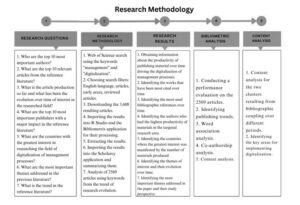
Figure 1: Research Stages
Source: Authors
To reach the objectives, we employed bibliometric analysis as a research method. This technique identifies significant contributions within a research area (Prioteasa et al., 2023). Many authors consider Bibliometric analysis a vital tool for identifying the most significant papers within a particular field. It is viewed as a research method used in specialized libraries to showcase relevant literature, established research methods, key authors, and highly cited articles through mathematical and statistical analysis (Shankar & Ramasesh, 2012).
The database used in the Web of Science comprises over 109 million documents compiled over time, starting in 1990. The necessary information was extracted in February 2024, based on the keywords “management” and “digitalization”, assigned as selection criteria articles, early articles, and reviewed articles written in English. The search resulted was 5,213 responses from 1991–2023, which were processed and interpreted with the help of the R Studio software application.
The development of technological means brought about the development of bibliometric analysis methods. As a result, the shift was made towards computer-assisted systems that automatically process data collected from specialized databases and can determine more accurately the primary scientific papers, publications, authors, and institutions involved (Lazarides et al., 2023). This analysis aims to measure the impact published articles have had on the maturity of concepts over time through their use in the development of new scientific research and the definition of new fields and trends of scientific approach (Iroaganachi et al., 2014).
In the contemporary context, multiple digital solutions are designed to support bibliometric analysis. Among these, for the present research, we used the Bibliometrix – R tool through the Biblioshiny interface (Aria & Cuccurullo, 2017).
Results and Discussion
After processing the data with the Bibliometrix application, a series of relevant data was synthesized in Table 1.
Table 1: Main data extracted from the analysis of the results
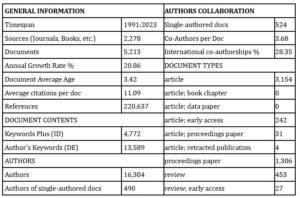
Source: Authors, processing with Bibliometrix based on the data from WOS
The average amount of research in digitalizing the management process has grown annually by 20.86%. The primary sources are 2,278 journals, out of which 5,213 papers were extracted, with an average of 111.09 citations per document. The total number of references to articles in the database is 220,637. A total of 16,304 authors contributed to the creation of the papers, out of which 490 are single authors, with the remaining 4,723 papers being co-authored. On average, 3.68 co-authors worked on a document, with 28.35% having written papers with international research partners (Table 1).
Analysis of Article Production Over Time
The analysis of the number of research articles published annually during the analyzed period shows that interest in digitalization was low until 2015, with one to 36 articles written annually (Figure 2).
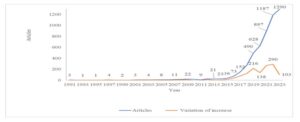
Figure 2: Graphical representation of the annual articles production trend
Source: authors, based on data from WOS
After 2016, the interest in the topics in the subject has gradually increased, being doubling reflected in the number of published papers per year. With the emergence of the pandemic phenomenon, the digitalization of management processes became a heavily analyzed subject, with the highest growth recorded in 2022, when 290 more articles were published compared to the previous year. However, in 2023, most research papers in management digitalization were published, with annual production reaching 1,290 research papers, although the increase from the previous year was only 8%. The analysis of the yearly variation of interest on the analyzed topic shows that, between 2015 and 2019, the digitalization of managerial processes was an active concern, with a yearly increase between 56% to 108% compared to the previous year.
After 2021, researchers’ interest waned. Analyzing the total production of specialized articles based on the interest shown by specialists can be started during the pandemic when most researchers in the field of management digitization processes were published. The interest in the topic maintained its course to the present day.
The analysis of article production by the number of authors shows that 88.46% of them contributed to single research, 8.31% participated in writing two articles, and 1.85% carried out three papers investigating the digitization of management. Only 1.37% of the authors participated in the writing of several research papers, out of whom two published 15 papers each (Table 2).
Table 2: Lotka Law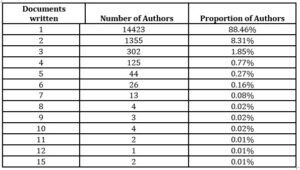
Source: authors, based on data from WOS
The Most Productive Journals
The analysis of each publication’s contribution to research based on the number of articles published throughout the entire research period shows that 30.17% out of the 2,278 sources analyzed published only one paper during the analysis period (Table 3). Over 50% of journals have published up to three articles in management digitization, which shows their need for more specialization in the field.
Table 3: Contribution of journals to the research base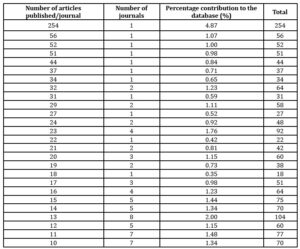
Source: authors, based on data from WOS
Moreover, based on the degree of contribution to the research base, the first ten journals comprise 13.06% of the total published papers. As the table reflects, the journals were ranked in descending order based on the number of published articles. The Sustainability journal ranks first contribution-wise, with 254 published papers, which translates into 4.87% of the analyzed database, more than five times the publications that follow it in the ranking. A preliminary conclusion would place sustainability among the areas of concern to which digitalization of management processes may be the optimal solution to achieve sustainability and efficiency goals (Figure 3). The journal publishes many papers annually, giving it a top position in many bibliometric analysis studies as far as the number of citations is concerned.

Figure 3: Top of the most important research sources
Source: authors, processing with Bibliometrix based on the data from WOS
Among the publications that contribute to Sustainability, there are five which distinguish themselves as the main source of contribution to research. The five publications are: “Energies” (published by MDPI, the same publisher as Sustainability), “Technological Forecasting and Social Change”, “Journal of Cleaner Production”, “Applied Sciences”, and “IFAC Papersonline”. Most of these journals have a direct link to digitalization, given their focus on technology, business environment, or innovation. Although the others focus on sustainability themes, energy efficiency, circular economy, and sustainable development, they are related to digitalization, all
these concepts being implementable through digital means.
The analysis of collaborative papers includes 4,274 research centers that have developed joint study programs. They are primarily universities but also ministries, such as the Ministry of Education and Science in Ukraine, which created a massive strategy of affiliation in research processes during the period 2021 – 2023, increasing from 25 affiliations in 2020 to 177 joint studies conducted with various universities in 2023 (Table 4).
Table 4: Most relevant affiliation
 Source: authors, processing with Bibliometrix based on the data from WOS
Source: authors, processing with Bibliometrix based on the data from WOS
Universities such as Peter the Great St. Petersburg Polytechnic University, State University of Management, Norwegian University of Science and Technology, and Bucharest
University of Economic Studies are the next in the ranking system, having an affiliation volume of approximately 20% compared to the Ministry of Education and Science of Ukraine (Figure 4).
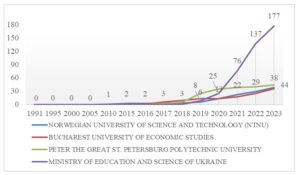 Figure 4: Affiliations’ Production Over Time
Figure 4: Affiliations’ Production Over Time
Source: authors with Bibliometrix, based on data from WOS
Analysis of Relevant Papers
In order to identify the most globally cited documents, the articles were analyzed based on the number of citations. As a result, Bibliometrix generated a top of 50 articles in terms of relevance, as it is reflected in Table 5.
Table 5: Most global cited documents
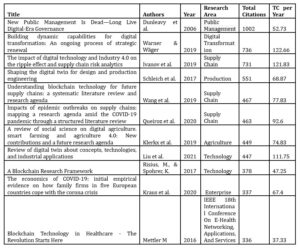 Source: authors, processing with Bibliometrix based on data from WOS
Source: authors, processing with Bibliometrix based on data from WOS
The number of global citations per paper ranges from 336 to 1002, with the ten most cited papers published between 2006 and 2021 focusing on topics such as supply chains, production, technology, agriculture, enterprises, digital transformation, and public management. The most cited paper was published in 2006 and has more than 50 citations per year, focusing on changes in public management in the digital age. Supply chains and digital transformation are becoming increasingly popular research areas. At the same time, automation through construction, agriculture, and production digitalization is
starting to gain attention. In public management, digitalization has shifted from the top of the list to the bottom, and information management has emerged as a new topic of interest, entering the top of the most cited papers.
Authorship and Citation Analysis
Among the authors with the most significant impact, there are ten researchers who, despite their valuable contribution consisting of nine to 15 articles published between 2017 – 2022, are not to be found among the most cited papers; table 6 reflects the foundation of the premise.
Table 6: Most relevant authors
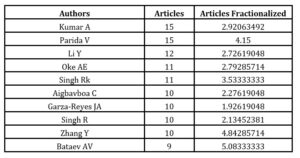
Source: authors with Bibliometrix based on data from WOS
Regarding the number of articles, the top three authors are Kumar, Parida, and Li. However, the most highly rated among these are Kumar and Parida, who have the highest number of published papers and global citations representing the greatest contribution to the research field, according to data from the WOS database.
The analysis of the same database based on the number of local citations reveals the most popular authors in the SSCI (Social Sciences Citation Index), a part of the Web of Science. The three top-ranked authors are Parida, Dolgui, and Ivanov (Figure 5). Parida is the only author appearing in both ranks; his academic research papers being appreciated in local and global databases.
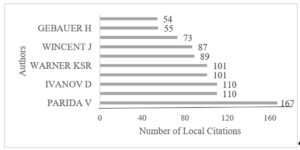
Figure 5: Most locally cited authors
Source: authors, with Bibliometrix based on data from WOS
Prioritizing the same rank by the average number of citations for each published paper results in a shift of position, from the first to the second place for Parida, being placed by Kumar, who started publishing research analyses in 2020. Except for Li and Zhang, all the other authors wrote their most popular papers from 2021 to 2023. This shows that the research themes brought about by the new researchers and their vision in the chosen area are of current interest. This resulted in the analysis of the fields addressed in the studies conducted by the most cited authors. The investigation showed that 60% of the experts discussed the issue of digitizing supply chains, 20% of service providers, 8% targeted
digitalization processes in health, and 6% each wrote an expertise paper about agriculture and business.
The authorship analysis by production over time reveals that the most long-lived author is Zhang, who has a period of analyses in the field of 22 years from 2001, followed by Li, who published his research in the field eight years later in 2009. The other authors became interested in digitalizing management processes after 2019, with the most productions made between 2021 and 2023 (Figure 6).
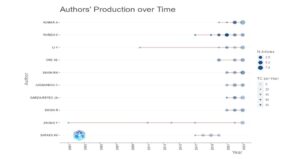
Figure 6: Authors’ production over time
Source: authors, with Bibliometrix based on data from WOS
Co-authorship Analysis
In order to conduct the analysis, articles were extracted from the WoS database and fed into the Bibliometrix application to provide a clearer picture of the connections between the authors. The application identified 16,304 authors in the selected articles. After applying the chosen criterion to a minimum of one article developed by the authors and 25 nodes per cluster, the software split the authors into ten clusters with different colors (Figure 7).
Cluster one (blue) has two authors, Centobelli and Cerchione, who are concerned about the digitalization of supply chains. Cluster two (grey) has three members, Vrontis, Chaudhuri, and Chatterjee, who wrote about digitalization management processes with the help of artificial intelligence. Cluster three (red) contains four authors: Sing, Gupta, Kumar R., Kumar M., and Gunasekaran, who are concerned with adopting Industry 4.0 and its advantages. Cluster four (green) is positioned by Kumar A, Li, and Garza-Reyes, who analyzed the applicability of augmented reality technology in the construction sector. In cluster five (brown) are Oke and Aigbavboa, who evaluated smart cities’ sustainable development. The other clusters have fewer members and smaller closeness and betweenness indicators.
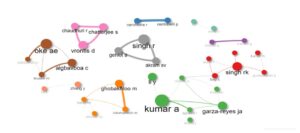
Figure 7: Collaboration networks of the most important co-authors
Source: authors, with Bibliometrix based on data from WOS
The analysis of the co-authors by country of origin resulted in five additional clusters of different colors. The largest group marked in red includes the authors from China, the UK, the USA, Turkey, Australia, Canada, Malaysia, and Brazil, who have addressed the digitalization of management processes under various aspects.
The most important ones focus on the impact of technological transformation at the organizational level from the point of view of sustainability, environmental protection, circular economy, and climate change, but also on the social impact, social responsibility regarding health status, and education of the employed
staff. The blue cluster contains authors from Germany, Spain, Sweden, Finland, Denmark, Switzerland, Spain, and France. The green cluster associates authors from countries such as Italy, Russia, Austria, Romania, and Portugal. The purple cluster comprises predominantly authors from Ukraine, and the orange cluster is from Poland (Figure 8).
The main themes addressed by the relevant authors focus on implementing digitalization in production, services, maintenance, supply and distribution chains, circular economy, energy efficiency, and information communication, as well as an orientation towards the concept of smart city and their economic and social impact.
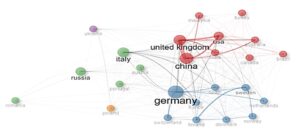
Figure 8: Co-authors network based on the researchers’ country of origin.
Source: authors, with Bibliometrix based on data from WOS
The formed groups highlight strong collaboration links between China, the UK, and the USA in the red cluster and Finland and Sweden in the blue cluster. Among the clusters, Italy has the strongest collaborations with the UK, China, Spain, and France. The analysis of the clusters shows collaboration between authors from the same region or with the same historical links.
National Contributions to Research
The contribution made by authors analyzed based on the country of origin of the correspondents identifies Germany as the most productive nation regarding research topics for the digitalization of management processes. This
is closely followed by China, Russia, Italy, Ukraine, the United Kingdom, Sweden, Spain, Finland, and India, each country contributing research papers ranging between 143 studies for India and 570 for Germany (Figure 9). The analysis was conducted based on two relevant indicators. The Multiple Country Publications (MCP) indicator highlights the pairs of authors who have obtained the most citations. In contrast, the Single Country Publications (SCP) indicator underlines the countries that have concentrated on collaborations with a significant impact on research.
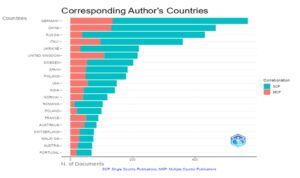
Figure 9: Analysis of national contributions to research
Source: authors, with Bibliometrix based on data from WOS
The investigation of the most cited nations positions Germany at the top of the ten most relevant countries out of the 94 identified. Next in the rank are the United Kingdom, Italy, China, Sweden, the USA, Finland, Australia, Spain, and Switzerland. The number of citations ranges from 1,003 for Switzerland to 5,159 for Germany (Table 7). The analysis of the data obtained from Bibliometrix shows that Germany is the most cited country by the total number of citations. However, the United Kingdom, Switzerland, the United States of America, and Australia precede it by the average number of citations per article.
Table 7: The most cited countries
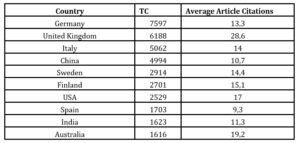 Source: authors, with Bibliometrix based on data from WOS
Source: authors, with Bibliometrix based on data from WOS
Examining the collaboration at a national level network reveals 1,290 international collaborations between countries. The most connections are those in the United Kingdom, China, Italy, India, and Australia, all of which have established research centers. While most nations engage in regional and global collaborations, many of these partnerships are with traditional allies (Figure 10).
Most collaborations are between China and the UK (66) and China and the USA (42), but also between the UK and the USA (42). At a short distance, Germany collaborates with the UK (40), Sweden with Finland (37), Italy with France (34) and the UK (32). The remaining connections have a frequency between one and 30 collaborations with a single third country.
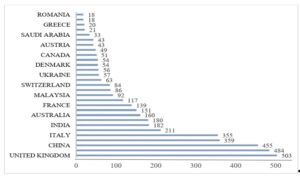
Figure 10: Frequency of national collaborations
Source: authors, processing with Bibliometrix based on data from WOS
Romania has developed international collaborations with ten countries, producing 12 papers in co-authorship, and is in the middle of the ranking, at the top of the 69 nations analyzed (Figure 10). Most of the collaborating countries are neighbors (Bulgaria, Hungary, Serbia, Slovenia) or Arab (Iraq, Saudi Arabia, United Arab Emirates), to which two Asian countries (Thailand and Pakistan) are added. Romania does not collaborate with any countries that are among the most developed research centers. The only country that is superior to Romania from the point of view of the research level is Israel, with all the other countries being equal or inferior from the point of view of knowledge in the field. On the other hand, Ukraine has 36 papers produced in collaboration with 13 countries and is ranked 21st at the top of international collaborations. Half of the Ukrainian partners are regional. However, they also collaborate with top research centers, such as France, the United Kingdom, Spain, and the Czech Republic, allowing them access to significant knowledge resources.
Moreover, international collaborations with developed countries allow them to develop superior technologies and transpose them into reality by capitalizing on the results.
Keywords Analysis
The analysis of the most frequent keywords, presented in Figure 11, shows that, out of 4,773 words analyzed, the first ten are “management”, “innovation”, “performance”, “impact”, “technology”, “framework”, “future”, “big data”, “model”, “challenge”. The word “management”, also a search key, appears three times greater than the rest of the words. The treemap of frequent words also includes words like: “design”, “Internet”, “implementation”, “transformation”, “technology”, “industry”, “strategy”, “integration”, “logistics”, “context”, “analysis”, “barriers”, “quality”, “knowledge”, “dynamics”, “models”, “strategies”, and “governance”. These are closely related to the field of analysis.
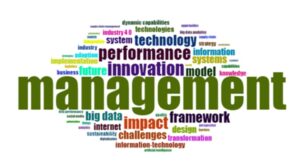
Figure 11: Graphical representation of the most important keywords
Source: authors, processing with Bibliometrix based on data from WOS
The evolution of authors’ keywords over time reveals the past and the current research trend as a central concern for the themes of the following period.
Digitalization has been a point of interest since 2014. The inherent result was the focus on developing online businesses and acquiring the skills needed to transition to the digital economy.
Since 2019, with the onset of the Covid 19 pandemic, researchers’ interest has shifted to digitizing management processes and analyzing technologies necessary for digital transformation, such as blockchain, the Internet of Things, and Industry 4.0. The year 2023 directed the interest of specialists towards the thematic investigation of the digitalization of waste management in Chinese companies (Figure 12).
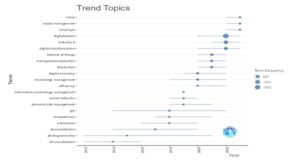
Figure 12: Trend of thematic concerns after authors’ keywords
Source: authors, with Bibliometrix based on data from WOS
More expressively, Figure 13 shows the thematic evolution of researchers’ interests over time by associating topics of interest, which are highlighted by the dimensions of connections. Digitization and using technologies have evolved towards streamlining business processes, while considering energy efficiency. Between 2022 and 2023, the central theme was the digitalization of management using artificial intelligence and the need for higher education. Also, topics such as “digitalization”, “risk management”, “quality management”, “logistics” and “telemedicine” were studied by the association in the pandemic context “covid 19”.
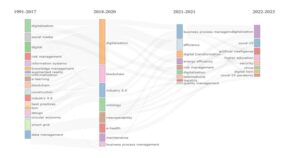
Figure 13: Thematic evolution of authors’ interest
Source: authors, with Bibliometrix based on data from WOS
Coupling the most relevant 250 documents into clusters led to forming three clusters with different centrality and impact. Cluster two, which analyzes organizations’ management, innovation, and dynamic capacity, has the highest frequency with the highest degree of centrality. Next in importance is cluster one, which
associates management, innovation, and big data analytics. It has a frequency halfway through cluster two but has a higher impact. The third cluster includes themes such as management, implementation, and future, and has the lowest frequency, but its impact is similar to cluster two (Table 8).
Table 8: Formed clusters and their influence

Source: authors, processing with Bibliometrix based on data from WOS
The analysis of the network of links between the two clusters shows the same phenomenon of higher coagulation in group one, where the keywords are “management”, “performance”, “innovation”, and “impact”, compared to group two, which is focused on “digitalization”, “framework”, “design”, “challenge” and “future” (Figure 14).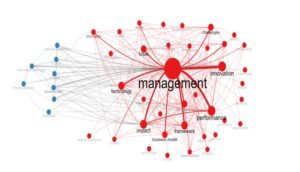
Figure 14: Neural network of keyword distribution across clusters
Source: authors, processing with Bibliometrix based on data from WOS
The thematic analysis of the key topics discussed in the relevant papers resulted in nine important thematic groups distributed over the four quadrants (Figure 15).
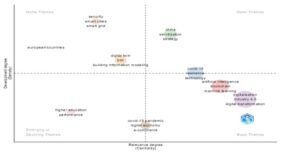
Figure 15: Map of thematic evolution
Source: authors, with Bibliometrix based on data from WOS
Declining themes are higher education and performance. The core topics heading for decline are the COVID-19 pandemic, the digital economy, and e-commerce. Central specialists’ investigations are heading towards digitization and digital transformation, using emerging technologies such as artificial intelligence, blockchain, machine learning, and Industry 4.0. Niche topics are addressed by European countries and concern building information modeling (BIM) and digital twin. Motor topics are topics on which specialists focus and aim to develop strategies in the service sector in China. The researchers are also investigating the role of technology as a resilience factor in the context of Covid 19.
Conclusions
The results of the performed bibliometric analysis illustrate the increased academic interest in the digitalization of management on a global scale. The research revealed top institutions’ propensity towards the subject, reflecting the vital role played by digitalization management within the contemporary context. The variation in researchers’ interest in the played area of interest shows the ability of specialists to adapt to contemporary issues regarding technological innovation and global challenges, such as the one created by the COVID-19 pandemic.
The main limitations of the investigation are represented by the analysis of relevant literature using a single database, Web of Science, strict limitation to papers written in English, and a lack of qualitative analysis of selected works. This excluded papers that may be relevant to the conducted analysis but are listed in other databases or written in different languages. Extending the analysis to additional databases could lead to identifying areas that have been understudied, such as modern management methods, concepts, and techniques, as well as emerging technologies in optimizing managerial decision-making processes. By analyzing these areas quantitatively and qualitatively, they will improve the accuracy of their research and better understand their impact. Also, the qualitative analysis of the extracted results could have allowed a more accurate assessment of the quality of studies, editors, and the impact of partnerships and collaborations between national and international co-authors. Another limitation may be using search words, which could be diversified by identifying a more specific and comprehensive search key. Nevertheless, the analysis results are valid and relevant to the investigated thematic framework.
The importance of the study lies in the global perspective on the evolution of digitalization at a theme level. Therefore, the area of research and the results registered are useful to both researchers and practitioners, as they fill a gap in previous research and constitute a good starting point for future investigations. The main direction of further research is represented by qualitative analysis of relevant highlighted literature and factors influencing the digitization of managerial processes and the adoption of technology in this field. Further investigations are also needed in areas such as modern methods, concepts, and techniques for digitizing management processes and optimal digitization strategies, identifying the pillars underlying successful digitalization processes. Regarding geographical regionality, the paper highlights that most collaborations are regional. Therefore, there is a need to explore collaborations with countries that have significant knowledge resources in the field of digitization of management processes, which include developed countries and emerging leaders in the field in developing countries, such as Germany, the UK, China, the USA, or India.
The importance of the study lies in the global perspective on the thematic evolution in the digitalization of management processes. Therefore, the area of research investigated and the results provided are useful to both researchers and practitioners, as they fill a gap in previous research and constitute a good starting point for future investigations. The uniqueness factor lies in the broadened coverage of the analyzed data, the timespan, and the choice of interpretation.
Discussions
The study’s findings indicate a significant shift in research focus towards digitalization and technological advances in management processes. This change is mainly driven by the competitive economic environment, in which digitalization offers a competitive advantage.
The research also revealed that the most influential articles in management digitization processes were written during the pandemic period. This suggests that the pandemic has accelerated the shift towards digitalization in management processes.
Moreover, the study highlighted the role of the journal Sustainability in disseminating research in this area. The journal’s prolific publication in this field suggests it could be an essential resource for researchers interested in managing digitization processes.
The topics approached over time ranged from data management, its use in the circular economy, Industry 4.0, and social media to the development of emerging technologies, digitization, and conversion to the digital economy with the risks and changes this entails through the development of skills to achieve qualitatively appropriate processes. The last years have been marked by the Covid 19 pandemic, which has highlighted the urgency of digital transformation, enabling the implementing of state-of-the-art technologies, and ensuring the security of data and systems. The analysis of the thematic evolution showed that the development of strategies in the field of services in China represents the main theme at present.
Additionally, the research focused strongly on growth and economic development among Asian authors, particularly in China. Nevertheless, the UK takes the leading role by entering all the relevant charts of specialized authors, documents, and significant affiliations. The UK is followed by China and Russia, the US, Germany, in descending order and the rest of the European countries. Based on these findings, we can draw a geostrategic map showing how China has led to Russia’s isolation in the war of digitalization through its strategic partnership with the UK. This suggests that these regions could lead the way in research on management digitalization processes.
The findings of this study have triggered the need for further research in this area. The limitations of the performed analysis, including the restriction to a single database and the absence of qualitative analysis of the extracted results, indicate that a more comprehensive understanding of management digitization processes could be obtained by examining additional significant scientific databases.
Acknowledgements
This paper is the result of research conducted within the Doctoral School of Management at the Bucharest University of Economic Studies.
References
- Aaen, J., & Nielsen, J. A. (2022). Lost in the diffusion chasm: Lessons learned from a failed robot project in the public sector. Information Polity, 27(1), 3–20. https://doi.org/10.3233/ip-200286
- Aria, M., & Cuccurullo, C. (2017). bibliometrix : An R-tool for comprehensive science mapping analysis. Journal of Informetrics, 11(4), 959–975. https://doi.org/10.1016/j.joi.2017.08.007
- Del Río Castro, G., González, C., & Colsa, Á. U. (2021). Unleashing the convergence amid digitalization and sustainability towards pursuing the Sustainable Development Goals (SDGs): A holistic review. Journal of Cleaner Production, 280, Article 122204. https://doi.org/10.1016/j.jclepro.2020.122204
- Cheng, L. (2022). Decision modeling and evaluation of enterprise digital transformation using data mining. Mobile Information Systems, 2022, 1–9. https://doi.org/10.1155/2022/2380100
- Chua, S., Östman‐Smith, I., Sellers, S., & Redman, C. W. G. (1991). Congenital heart block with hydrops fetalis treated with high-dose dexamethasone; a case report. European Journal of Obstetrics & Gynecology and Reproductive Biology, 42(2), 155–158. https://doi.org/10.1016/0028-2243(91)90176-l
- Cicea, C. Simion, C.P., & Marinescu, C. (2023). Leveraging Opportunities for Public Sector Digitalisation: A Macroeconomic Analysis. Management and Economics Review, 8(3), 387-396. https://doi.org/10.24818/mer/2023.10-10
- European Commission. (2022). Romania in the digital economy and society index. (n.d.). Shaping Europe’s digital future. https://digital-strategy.ec.europa.eu/en/policies/desi-romania
- Dubravac, T., Benko, M., & Cavlovic, J. (2005). The structure of uneven-aged stands in non-economic forests of national park Risnjak in Croatia. Ekológia, 24(4), 385-396. https://eurekamag.com/research/004/485/004485384.php
- Dunleavy, P., Margetts, H., Bastow, S., & Tinkler, J. (2005). New Public Management is Dead–Long Live Digital-Era Governance. Journal of Public Administration Research and Theory, 16(3), 467–494. https://doi.org/10.1093/jopart/mui057
- Dwivedi, Y. K., Hughes, L., Kar, A. K., Baabdullah, A. M., Grover, P. S., Abbas, R., Andreini, D., Abumoghli, I., Barlette, Y., Bunker, D., Kruse, L. C., Constantiou, I. D., Davison, R. M., Dé, R., Dubey, R., Fenby-Taylor, H., Gupta, B., He, W., Kodama, M., . . . Wade, M. (2022). Climate change and COP26: Are digital technologies and information management part of the problem or the solution? An editorial reflection and call to action. International Journal of Information Management, 63, Article 102456. https://doi.org/10.1016/j.ijinfomgt.2021.102456
- Esteve, M., Palau, C. E., Martínez-Nohales, J., & Molina, B. L. (2007). A video streaming application for urban traffic management. Journal of Network and Computer Applications, 30(2), 479–498. https://doi.org/10.1016/j.jnca.2006.06.001
- Falk, R. H., & Leavitt, J. I. (1991). Digoxin for Atrial-Fibrillation – A Drug Whose Time Has Gone. Annal of Internal Medicine, 114(7), 573–5. https://doi.org/10.7326/0003-4819-114-7-573
- Iroaganachi, M.A., Itsekor, V., & Osinulu, I. (2014). CITATION ANALYSIS OF SOCIAL SCIENCE RESEARCH: A CASE STUDY OF BACHELOR DEGREE RESEARCH PROJECT REPORTS OF A NIGERIAN UNIVERSITY 2009-2013. Library Philosophy and Practice, 1, Article 1096.
- Jahani, N., Sepehri, A., Vandchali, H. R., & Tirkolaee, E. B. (2021). Application of Industry 4.0 in the Procurement Processes of Supply Chains: A Systematic Literature review. Sustainability, 13(14), Article 7520. https://doi.org/10.3390/su13147520
- Jarach, D. (2002). The digitalisation of market relationships in the airline business: the impact and prospects of e-business. Journal of Air Transport Management, 8(2), 115–120. https://doi.org/10.1016/s0969-6997(01)00039-4
- Kohtamäki, M., Parida, V., Patel, P. C., & Gebauer, H. (2020). The relationship between digitalization and servitization: The role of servitization in capturing the financial potential of digitalization. Technological Forecasting and Social Change, 151, Article 119804. https://doi.org/1016/j.techfore.2019.119804
- Kolmykova, T., Klykova, S. V., & Makarov, N. (2020). Digitalization as a New Paradigm of Socio-Economic Development. Scientific Library, Biologically Inspired Cognitive Architectures, 2021, 344–354. https://doi.org/10.36871/ek.up.p.r.2020.11.05.001
- Kumar, A., Agrawal, R., Wankhede, V. A., Sharma, M., & Mulat-Weldemeskel, E. (2022). A framework for assessing social acceptability of industry 4.0 technologies for the development of digital manufacturing. Technological Forecasting and Social Change, 174, Article 121217. https://doi.org/10.1016/j.techfore.2021.121217
- Lazarides, M. K., Lazaridou, I., & Παπάνας, Ν. (2023). Bibliometric Analysis: Bridging Informatics with science. The International Journal of Lower Extremity Wounds, 0(0), Article 153473462311535. https://doi.org/10.1177/15347346231153538
- Lenka, S., Parida, V., & Wincent, J. (2016). Digitalization capabilities as enablers of Value Co‐Creation in servitizing firms. Psychology & Marketing, 34(1), 92–100. https://doi.org/10.1002/mar.20975
- Li, J., & Kassem, M. (2021). Applications of distributed ledger technology (DLT) and Blockchain-enabled smart contracts in construction. Automation in Construction, 132, Article 103955. https://doi.org/1016/j.autcon.2021.103955
- Lin, X. Z., Chang, T. M., Tsai, H. M., Sun, Y. N., Sheu, B. S., & Jen, C. M. (1999). Liver, spleen, and tumor volume measured by personal computer. Hepatogastroenterology, 46(26), 838-842, PMID: 10370623
- Meier, C. (2017). Managing Digitalization: Challenges and Opportunities for Business. Management 12(2), 111–113, https://doi.org/10.26493/1854-4231.12.111-113
- Mina-Raiu, L., & Melenciuc, M. (2022). The Role of Digitalisation in the Process of Improving the Quality of Urban Public Services. Theoretical and Empirical Researches in Urban Management, 17(4), 22-35.
- Nell, P. C., Foss, N. J., Klein, P. G., & Schmitt, J. (2021). Avoiding digitalization traps: Tools for top managers. Business Horizons, 64(2), 163–169. https://doi.org/10.1016/j.bushor.2020.11.005
- Prioteasa, A. L., Ciocoiu, C. N., Lazăr, L., & Minciu M. (2023). E-Learning in Higher Education during the COVID-19 Pandemic: A Bibliometric Analysis, Proceedings of the International Conference on Business Excellence, 17(1), 1858-1872. https://doi.org/10.2478/picbe-2023-0164
- Schmidt, C. G., & Wagner, S. M. (2019). Blockchain and supply chain relations: A transaction cost theory perspective. Journal of Purchasing and Supply Management, 25(4), Article 100552. https://doi.org/10.1016/j.pursup.2019.100552
- Semenіuk, S. (2022). Digitalization of the enterprise’s marketing management process. Socio-Economic Problems and the State, 35–44. https://doi.org/10.33108/sepd2022.nom2.035
- Sestino, A., Prete, M. I., Piper, L., & Guido, G. (2020). Internet of Things and Big Data as enablers for business digitalization strategies. Technovation, 98, Article 102173. https://doi.org/10.1016/j.technovation.2020.102173
- Seyedghorban, Z., Samson, D., & Tahernejad, H. (2020). Digitalization opportunities for the procurement function: pathways to maturity. International Journal of Operations & Production Management, 40(11), 1685–1693. https://doi.org/10.1108/ijopm-04-2020-0214
- Shankar, M. P., & Ramasesh, C. P. (2012). Citation analysis of the papers presented at WIS International Conference 2010. Business, Article 64473129
- Shen, L., Sun, W., & Parida, V. (2023). Consolidating digital servitization research: A systematic review, integrative framework, and future research directions. Technological Forecasting and Social Change, 191, Article 122478. https://doi.org/10.1016/j.techfore.2023.122478
- Shin, K., & Leem, C. S. (2002). A reference system for internet based inter-enterprise electronic commerce. Journal of Systems and Software, 60(3), 195–209. https://doi.org/10.1016/s0164-1212(01)00092-9
- Shirokova, S., Solovyov, L. A., Gnatenko, E., & Lohyeeta, N. (2020). Implementation of the digital transformation concept during decision-making process in a construction company. Proceedings of the International Scientific Conference – Digital Transformation on Manufacturing, Infrastructure and Service, 6, 1–8. https://doi.org/10.1145/3446434.3446464
- Sima, V., Gheorghe, I. G., Subić, J., & Nancu, D. (2020). Influences of the Industry 4.0 Revolution on the human capital Development and Consumer Behavior: A Systematic review. Sustainability, 12(10), Article 4035. https://doi.org/10.3390/su12104035
- (2023). Digital transformation spending worldwide 2017-2026. https://www.statista.com/statistics/870924/worldwide-digital-transformation-market-size/
- Tiwari, M. (2021). Invited Session on: Decision Analytics and Digitization for End-to-End Supply Chain Transformation. IFAC-PapersOnLine, Business, Computer Science, Article 259367645.
- Warner, K., & Wäger, M. (2019). Building dynamic capabilities for digital transformation: An ongoing process of strategic renewal. Long Range Planning, 52(3), 326–349. https://doi.org/1016/j.lrp.2018.12.001
- Zaslavskaya, V. L. (2022). Decision Support Systems And Their Role In Information Management Systems. Ekonomika I Upravlenie, Article 256592064. https://doi.org/10.36871/ek.up.p.r.2022.12.02.017
- Zvirgzdiņa, R., Skadina, H., & Linina, I. (2023, 08 04). Appropriate Communication of the Strategy as an Impact Factor for Business Model Digitalization, Wseas Transactions on Business and Economics, 20, 1709-1718. https://doi.org/10.37394/23207.2023.20.151

























